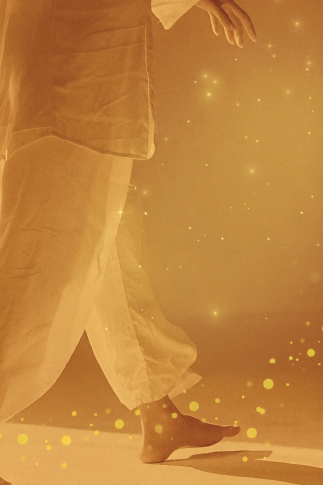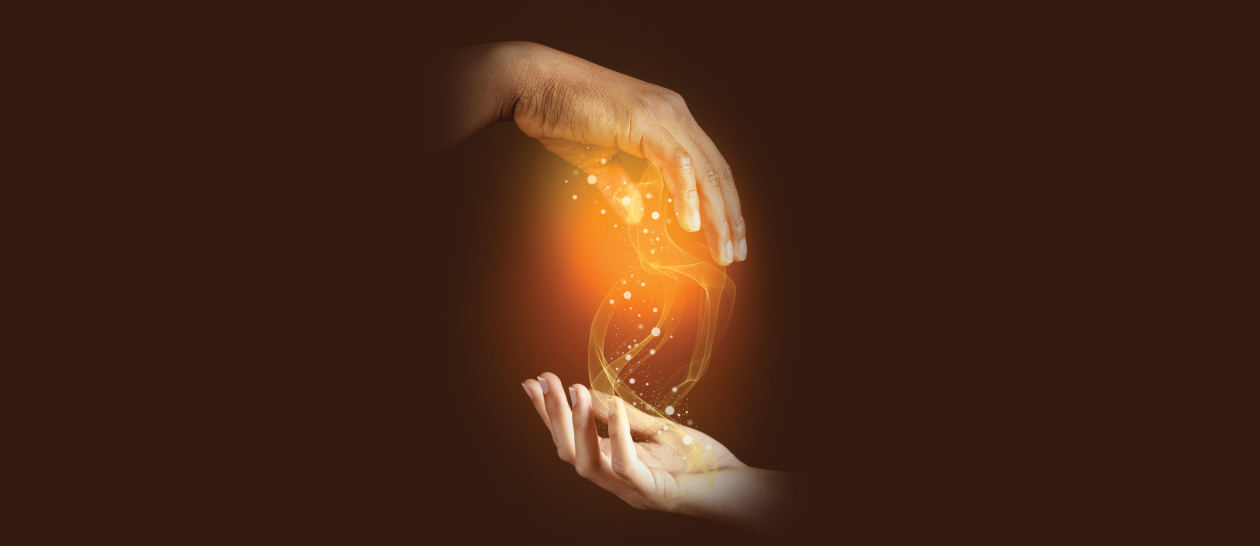DAAJI maps the evolving relationship between guide and seeker through stages of recognition, resistance, and surrender, showing how what begins as external guidance must ultimately awaken as an inner connection to the Divine.
A fundamental truth of walking the spiritual path is that one must find oneself a capable guide. A living guide is a crucial factor in spiritual evolution, as without someone to help us, we struggle to transcend our limitations. For a long time, most of us have been pushing ourselves from within, but an external push is also needed. There is a limit to what we can achieve on our own, and we come to realize that this is a field in which we need guidance to progress. In the Heartfulness system, nature has ensured the continuous presence of a living guide among us since the time of Lalaji Maharaj, the system’s founder. Saints from the past live on through their teachings and works, but just as a burned-out candle cannot illuminate a dark room, a guide from ages past cannot help you transform yourself now.
Once you have recognized your guide, it is natural to wonder about the extent to which you need to interact with them. The relationship does not depend on human-level contact; yet, it is enormously beneficial to meet your guide at least once in your lifetime. If your attitude is correct, once may even be enough! You don’t have to shake the guide's hand or even converse. Still, if you are receptive and present around them even once, your entire spiritual journey can be plotted out in that one meeting. Beyond that, any encounter can be considered a bonus. We need not follow the guide around, as often happens. We don’t need to worship the guide. So many people believe that the guide’s physical being contains the Ultimate Source, and that by worshipping him, they will somehow siphon off some of that power into themselves. What we fail to remember is that the Source is everywhere and nowhere. The only place you will find it is within yourself. The purpose of your guide is to lead you to the inner Self.
Who is a Real Guide?
Most people struggle with identifying a capable guide. A true spiritual guide is a giver, whereas most of them today seem to be receivers—they expect some form of guru dakshina (traditional fees), they enjoy being worshipped, they want to be followed and revered. These days, if a man wears ochre robes or displays a knowledge of ancient texts and speaks some wise words, he becomes a guru. Ultimately, a guru’s primary responsibility is the spiritual progress of each disciple under his care. If he fails to carry out his responsibilities, whether due to inability or unwillingness, I believe nature will hold him accountable.
So, what makes a real guide?
Babuji Maharaj has defined two essential traits:
that a worthy guide is someone
who possesses the power to transmit their own force
for the transformation of man,
and also someone in whose physical company
you immediately begin to experience a state of peace.
So, what makes a real guide? Babuji Maharaj has defined two essential traits: that a worthy guide is someone who possesses the power to transmit their own force for the transformation of man, and also someone in whose physical company you immediately begin to experience a state of peace.
For example, in my own experiences with Babuji, he never carried himself as a master. He always seemed to regard himself as someone insignificant, with absolute humility. I saw a similar attitude in Chariji. He would only ever describe himself as a disciple of Babuji. Contrary to how many self-proclaimed gurus comport themselves, a real one considers himself a servant. It was clear from Babuji’s example that a real master can never entertain the notion that he is, in fact, a master, for this paradoxically renders him unfit for the job.

A true guide must be capable of taking you not just to moksha (liberation) but far beyond, toward higher states of consciousness and realization. It is the guide who carries the seeker across inner obstacles that cannot be overcome alone. Even at the highest stages where surrender becomes complete, the seeker may start to feel inertia and lose the desire to progress. Here, the guide reappears to take the seeker forward gently.
This journey is fueled by yogic transmission, of which the guide is the custodian. Yet, a single reception of divine grace can accomplish what countless transmissions may not. Grace is subtle, powerful, and must be experienced to be understood.
In Heartfulness, without transmission and grace, the practice loses its essence. The guide serves as a conduit for both.
If ever you feel the need to confirm your bond with your guide, pay attention to your heart. The mind may always question, as that is its nature, but heavy, persistent doubt in the heart is a clear sign. If your heart feels unsettled or burdened, it likely means this person isn’t meant to guide you. If you ever feel genuinely unsatisfied, you always have the freedom to walk away. The choice is yours. It would be better to walk on your own than to entrust your progress to an incapable guide.
On the other hand, when your heart feels content, don’t entertain mental doubts forever. Now is the time to commit and focus on your practice.
Prepare Yourself
These days, many people approach their spiritual guide primarily for help with worldly matters. Overwhelmed by daily struggles, they often think, “If my guide isn’t going to solve my problems, then what’s the point of going to him?” They tend to visit him on special occasions—birthdays, anniversaries, weddings, housewarmings, new jobs, or business ventures—or to share grievances about others. But what happens when we approach our guide with such specific requests? The very act of expecting, whether for material gain or spiritual advancement, creates a distinct barrier. That expectation becomes a block, preventing the natural flow between the heart of the guide and ours. The guide may be ready to give far more than what we ask for. By limiting ourselves to small, transactional desires, we miss the greater possibilities.
What is a true blessing? It is something that helps us solve the mystery of life and fulfill our soul’s purpose. If even once in your life you receive such a blessing from your guide, how insignificant it seems to ask for birthday blessings!
A lot, therefore, depends on the attitude we carry into that meeting. It is extremely rare for someone to approach their guide with no expectation, only pure love. When such a thing happens, it reflects the true spirit of nishkam karma, the desireless action extolled by Lord Krishna. When the heart is free of expectation and full of sincere love, a true guide naturally responds. No words are needed. In that moment, a deep connection forms between the seeker and the guide—a quiet communion where both hearts understand each other completely. This inner resonance happens effortlessly. Both begin to vibrate in harmony, in total silence, without the need for explanations or reassurances. But when the heart is crowded with constant desires, repeating the same patterns year after year, this natural connection is delayed. What could have occurred in a single moment may now take many lifetimes to unfold.
When the heart is free of expectation and full of sincere love,
a true guide naturally responds. No words are needed.
In that moment, a deep connection forms
between the seeker and the guide—
a quiet communion where both hearts
understand each other completely.
This inner resonance happens effortlessly.
Both begin to vibrate in harmony, in total silence,
without the need for explanations or reassurances.
Unfortunately, there is often a lot of shame and guilt amongst people that can prevent them from coming face-to-face with their guide. A disciple may think, “I have not done my practice these past days. I am in no condition to see him.” Then, someone nearby further hinders him, saying, “Move along! He doesn’t want to meet anyone.” Maybe true, maybe not, but this paradoxical approach to being with one’s guide has to be well understood: when to avoid being an imposter, and how to connect with him despite distances.
But we mustn’t forget that personal work is the catalyst. Through regular spiritual practice, day after day, we shape and prepare our hearts to receive what the guide has to offer. You may meet him every day, share meals and converse with him, but without your inner efforts, the mere presence of the guide cannot stir up any miracles.
In the Presence of the Guide
The inspiration and pull to sit in the guide’s presence can only come from within. Too often, I find that certain individuals, such as new seekers or children, are pushed in front of a spiritual guide prematurely. Without any foundation in spiritual practice, it’s difficult to appreciate what the guide offers in that moment. Special care must be taken with children. There is no point in pushing them to do anything in front of the guide that they are not used to or comfortable with, such as offering pranaams, saying “Namaste,” taking prasad, or behaving a certain way in the ashram. All these are sure to build up resentment and cause them to rebel against the circumstances.
Is it not better to approach the guide with a heartfelt sentiment? When a sincere disciple leaves home to meet their guide, their inner anticipation is one of love, yearning, and eagerness. When they are about to come into his proximity, they enter with gentleness and a prayerful heart. They walk lightly, carefully. All their ideas, wishes, and opinions drop off naturally, at least for the moment, as they prepare to accept whatever it is the guide wishes to impart. Ideally, they will not try to analyze the guide or draw conclusions about his actions. That is unbecoming of a disciple and only blocks the subtle work he is trying to do. In the guide’s presence, our sense of individuality must take a backseat. And even if it doesn’t fully dissolve, a true disciple at least maintains a respectful, inward silence.

When a sincere disciple leaves home to meet their guide,
their inner anticipation is one of love, yearning, and eagerness.
When they are about to come into his proximity,
they enter with gentleness and a prayerful heart.
They walk lightly, carefully.
As Babuji once remarked, “Many come to see me, but nobody really sees me!” Usually, we see only that which we can grasp with the level of consciousness and understanding we possess at any given time. Most people, when they try to observe the guru, end up missing the guru’s essence. They try to copy his worldly examples: they mimic his actions, gestures, dress, or mannerisms. However, this is not their fault. To accurately assess something or someone, we must be more subtle than that object. That’s the main reason why the true nature of the spiritual guide eludes the disciple. His degree of subtlety makes it nearly impossible for us to observe him. At best, we see him as a refined personality who often speaks wise truths.
Through practice, we become more subtle and begin to grasp our guide’s inner nature.
When Ego Interferes
Back in the mid-1990s, I would visit my guide, Chariji, as often as possible, at least five or six times a year, and stay with him for extended periods. Seeing my frequent trips, a neighbor once asked me, quite innocently, “Kamlesh bhai, why do you need to keep visiting Chariji again and again? Didn’t Babuji attain self-realization in just seven or eight meetings with Lalaji Maharaj? Is it really necessary to go so often?”
I did not have an answer for her, but I promised I would ask Chariji on her behalf.
Later, when I was with Chariji in India, I posed the question: “There’s a practitioner who wonders, what is the real need to see you again and again?” He gave a beautiful explanation. “You can admire the beauty of a flower from afar. But to inhale its fragrance, you will need to go near it. If it is a rose, and you hold that flower in your hands, beware, there are thorns as well that can prick you. That’s why we may avoid the masters.” For as many opportunities as the guide’s physical presence holds, there are also hazards. When faced heartfully, these risks transform into even greater blessings. But if the heart fails to melt in such situations, they become the instruments of your spiritual tragedy.
As devotion grows, the guide draws nearer and becomes more available.
This new availability marks a turning point in the disciple’s journey.
Transformation deepens, spiritual states intensify,
and gratitude often overwhelms the heart.
These tests are part of the journey. In the beginning, they’re simple. We may think, “I don’t feel like meditating.” When you find yourself struggling with your Heartfulness practice, take it for granted that a new spiritual stage is approaching. Don’t let it drag on. Go to a trainer, take one or two sittings, and move through it quickly. If you overcome that resistance and meditate despite the lack of motivation, a new condition will naturally emerge.
The challenges that follow become significantly more perilous: they involve the ego.
The guide quietly observes both love and hatred as they arise in the disciple’s heart. Even love can carry an aggressive energy, the intense drive to overcome all barriers to reach the Beloved. Similarly, anger or a desire to withdraw is aggression turned in another direction.
Despite these emotional surges, the guide patiently works to refine the disciple’s ego. To do so, he creates carefully tailored circumstances, always treading gently. But during this critical time of transformation, the disciple feels pain, and the guide, being human, feels it too. Regardless, the guide must continue on this trajectory.
As devotion grows, the guide draws nearer and becomes more available. This new availability marks a turning point in the disciple’s journey. Transformation deepens, spiritual states intensify, and gratitude often overwhelms the heart. But even here, dangers arise. The disciple may begin to feel spiritually superior or more significant than others. When this happens, the guide’s heart is devastated.
Being in closer proximity to the guide also brings an unprecedented challenge regarding our perception of him. What once was perceived as sacred may now seem flawed as the guide’s human traits become visible. This shift in perception can either deepen the disciple’s growth or become an obstacle—it all depends on the inner maturity of the seeker.
From a limited level of consciousness, it’s hard to perceive the higher dimensions. The guide now becomes a mirror, reflecting the disciple’s attitudes, expectations, and unresolved burdens. Identifying one’s own challenges with one’s guide now gives rise to doubt, disagreement, and emotional resistance, gradually building a wall between the guide and the disciple. Whether this wall solidifies or dissolves depends entirely on the disciple. If faced with awareness and a heart that truly longs for the Divine, this stage can become a powerful turning point.
There’s no harm in inwardly assessing one’s guide. In fact, at specific points on the journey, it becomes necessary, as one can’t move forward without that inner clarity. Doing so doesn’t disrespect the guide in any way. It is only when the heart feels fully assured that we are willing to let down the walls of our individuality. But in nearly every case, it’s our sense of self-importance that gets in the way. More often than not, it is because the guide’s suggestions and corrections can be painful to accept, as the ego resists being challenged. Like the Hydra from Greek mythology, when one head is destroyed, two more quickly grow in its place: the more we fight the ego, the stronger it becomes. This cycle continues until we recognize the futility of this battle, and finally, we choose to surrender, genuinely and with love. How long will we continue to postpone this? Our time together is limited; we don’t have eternity at our disposal. Once the heart feels convinced, it is time to let go and offer our full availability.
When love takes over, these barriers naturally fade. With resistance gone and courage awakened, the drop becomes ready to merge into the Ocean—we attain oneness with the Divine.
Meeting the Guide Within
While our guide is the caretaker of our spiritual progress, he can also become the most significant obstacle on our path, as we continue to depend on him for everything. You keep telling yourself, “It’s okay if I relax, his grace will take care of everything.” It’s nonsense. There’s no doubt that a true spiritual guide’s support is always there, but you have to do your part. You must put in the effort and work sincerely on your transformation. That is why I am sometimes compelled to tell people to live as if their guide is dead. It’s a way of encouraging ownership and commitment. It is the aspirant’s sincere effort that draws the guide’s energies. When you take one step forward on the path, he helps you take another. The only difference is that while your step is small, the guide’s step can cover vast dimensions of consciousness.

The spiritual guide is nature’s response to the sincere call of a seeker.
As Babuji has said, the yearning call of an aspirant
brings the guide to their door.
Sometimes, just a single moment of transmission
is enough to awaken your sense of deeper purpose.
If the seeker is receptive, they are drawn toward the guide.
Transcending all mundane barriers, the guide’s work occurs from afar, and one does not need to be in the guide’s physical presence for that work to take place. The guide need not even know your name or be familiar with your face. Such conscious knowledge is unnecessary for his work. He might even be unaware that he is working on you, because spiritual work proceeds automatically from the heart. The guru-aspirant relationship is an inner one, cultivated in the privacy of the heart. Babuji, with his profound understanding, has fundamentally transformed the entire approach to spirituality. He explains that even if we cannot love the guide, or even God, there is nothing wrong so long as you have the simple desire that you would like to arrive at the state of love, for which he prescribes constant remembrance. The logic of constant remembrance is simple: when you love someone, you remember them constantly. Conversely, if you continuously remember someone with a sense of belonging, love cannot help but bubble up in the heart.
The spiritual guide is nature’s response to the sincere call of a seeker. As Babuji has said, the yearning call of an aspirant brings the guide to their door. Sometimes, just a single moment of transmission is enough to awaken your sense of deeper purpose. If the seeker is receptive, they are drawn toward the guide. But this movement cannot be forced. The seeker’s heart must give permission. A true guide never imposes; he works in harmony with the heart’s willingness, and even the most powerful guru cannot bring about inner transformation if the heart resists.
That’s why real change depends on the aspirant’s readiness. In the dynamic between a seeker and a capable guide, it is always the seeker who holds the key, never the guide.

Daaji
Kamlesh Patel is known to many as Daaji. He is the Heartfulness Guide in a tradition of Yoga meditation that is over 100 years old, overseeing 14,000 certified Heartfulness trainers and many volunteers in over 160 countries. He is an inn... Read More

